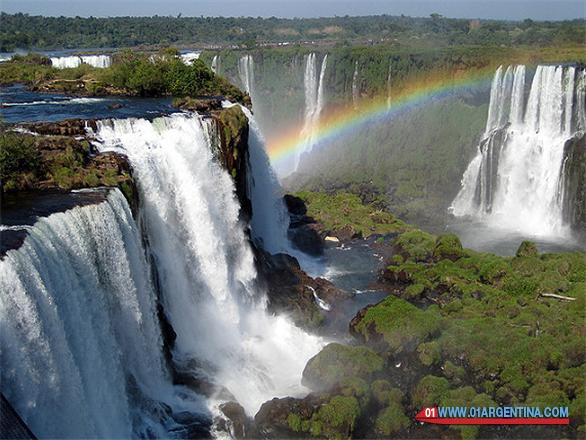NATIONAL PARK IGUAZU FALLS
Iguazu Falls, one of the Seven Wonders of the World, magnificent are formed by 275 waterfalls falling from the most diverse heights. The highest, 80 meters, is known as the Devil’s Throat.
A unique context plant part to one of the world’s most opulent landscapes: the Iguazu Falls. It is more than 2 km of waterfalls over 70 meters high, a spectacular manifestation of one of the increasingly scarce resources of the planet: water.
Jumps pass along cliffs and islets spread over a crescent forming this geographical accident. The trails can be explored on foot or opt for a picturesque train of the jungle, combustion gas, which leaves from the Visitor Center.
In Iguazu they can be found, basically, through two circuits: one upper and one lower. From the bottom you get to the base of the falls, where the force of water is converted into steam spray or dip to competing. The experience is unique and worth daring the adventure. Since this circuit can also take a boat to San Martin Island.
In the upper rung, the ride is more sedentary. The panoramic views from the walkways and viewpoints make the stay an unforgettable experience.
The Iguazu National Park is a protected area that has one of the most biologically rich sites in Argentina.
This environment is popularly known by the name of Atlantic Forest. Here is half of the species of birds recorded in the Argentine territory and the greatest diversity of orchids in the country, to cite just a few examples.
The park was created in 1934 and is one of the first in Argentina. In addition to its scenic beauty, she has high scientific value, as it provides the context for studying endangered species such as the jaguar. The area is a “school” outdoors where children and youth can understand the multiple relationships between living things. Moreover, the movement generated by tourism is the main engine of economic development in the region.
PUERTO IGUAZU
This city was a mainstay of the colonization of the Province in the early twentieth century. Today, it is one of the most important locations of Misiones. More than 60,000 people inhabit this resort, where you can find all kinds of services for the traveler visiting Iguazu.
It is also the gateway to the Triple Frontier with Brazil and Paraguay. In the neighboring city of Foz de Iguazu in Brazil, you will come across the international bridge Tancredo Neves, from which you can cross to the Paraguayan city of Ciudad del Este.
Walking Highlights
The Aripuca
It is a proposed sensitize visitors about the effects that the indiscriminate felling of trees and care for the environment, and shows how it was made sometime missionary jungle theme park.
The aripuca is a Guaraní Indian trap was used to catch animals without hurting them. This draft agroecotourism playing a supersized aripuca to illustrate the richness of the forest of Misiones. This way people can learn about the characteristics of the logs that form, the approximate growth and geographic distribution, as well as its potential and actual usefulness. He also learns about the Guarani culture through an indigenous element that was used in their hunting practices.
Moconá
The Moconá is one of the great landscapes of the province of Misiones. It is a geological, only flaw of its kind in the world, where Yabotí, Pepirí Guazú, Uruguay, Serapio and Calixto Rivers meet.
Moconá Falls, which means “He who swallows everything” in Guarani, form a canyon 3 km long parallel with cross falls to normal water, unlike a waterfall or a waterfall. These falls can reach 25 meters. height and a depth of 115 meters.
The whole area of the Moconá is categorized as Provincial Park and includes the so-called Biosphere Yabotí.
It is the ideal place to live an experience of contact with nature at its finest place: trekking, animal sightings and boat rides and kayaking in the jungle of Misiones.
San Ignacio
Today San Ignacio Mini is the best preserved of the Jesuit missions of the sixteenth and seventeenth centuries in Argentine territory. Around a central plaza the church distributed, Casa de los Padres, the cemetery, the houses and the town hall.
In San Ignacio building local stone was used, red sandstone, in large pieces.
The dimension of the work has meant that, despite years of decline, most of the walls still standing.
The San Ignacio Mini Jesuit Reduction, along with those of Our Lady of Loreto, Santa Ana and Santa Maria Maggiore (located in Argentina) were declared World Heritage Site by Unesco in 1984.
In turn, the city of San Ignacio is a resort with exciting landscapes like the Rock of Teyú Cuaré the Yabebirí river and natural beauties scattered throughout its length, framed by the majestic native flora that filters through every corner.
PROVINCIAL PARK TEYÚ CUARÉ
Located in San Ignacio, it was created to protect a rocky outcrop of unique scenic value. Its natural caves provide shelter for numerous species of bats. It is a place of historical and cultural value that has inspired the writer Horacio Quiroga.










